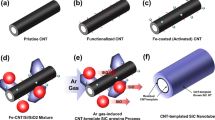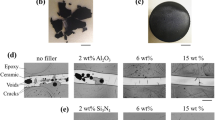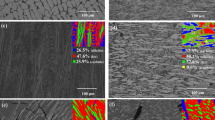Abstract
There has been growing interest in incorporating single-wall carbon nanotubes (SWNTs) as toughening agents in brittle ceramics. Here we have prepared dense Al2O3/SWNT composites using the spark-plasma sintering (SPS) method. Vickers (sharp) and Hertzian (blunt) indentation tests reveal that these composites are highly contact-damage resistant, as shown by the lack of crack formation. However, direct toughness measurements, using the single-edge V-notch beam method, show that these composites are as brittle as dense Al2O3 (having a toughness of 3.22 MPa m0.5). This type of unusual mechanical behaviour was also observed in SPS-processed, dense Al2O3/graphite composites. We argue that the highly shear-deformable SWNTs or graphite heterogeneities in the composites help redistribute the stress field under indentation, imparting the composites with contact-damage resistance. These composites may find use in engineering and biomedical applications where contact loading is important.
This is a preview of subscription content, access via your institution
Access options
Subscribe to this journal
Receive 12 print issues and online access
$259.00 per year
only $21.58 per issue
Buy this article
- Purchase on Springer Link
- Instant access to full article PDF
Prices may be subject to local taxes which are calculated during checkout







Similar content being viewed by others
References
Zhan, G.-D., Kuntz, J.D., Wan, J. & Mukherjee, A.K. Single-wall carbon nanotubes as attractive toughening agents in alumina-based nanocomposites. Nature Mater. 2, 38–42 (2003).
Ruoff, R.S. & Lorents, D.C. Mechanical and thermal properties of carbon nanotubes. Carbon 33, 925–930 (1995).
Iijima, S., Brabec, C.H., Maiti, A. & Bernholc, Z.J. Structural flexibility of carbon nanotubes. J. Phys. Chem. 104, 2089–2092 (1996).
Treacy, M.M.J., Ebbesen, T.W. & Gibson, J.M. Exceptionally high Young's modulus observed for individual carbon nanotubes. Nature 381, 678–680 (1996).
Subramooney, S. Nanocarbons—structure, properties, and potential applications. Adv. Mater. 15, 1157–1475 (1998).
Calvert, P. Recipe for strength. Nature 399, 210–211 (1999).
Yu, M.F., Files, B.S., Arepalli, S. & Ruoff, R.S. Tensile loading of ropes of single wall carbon nanotubes and their mechanical properties. Phys. Rev. Lett. 84, 5552–5555 (2000).
Baughman, R.H., Zakhidov, A.A. & deHeer, W. A. Carbon nanotubes—the route toward applications. Science 297, 787–792 (2002).
Ma, R.Z., Wu, J., Wei, B.Q., Liang, J. & Wu, D.H. Processing and properties of carbon nanotubes–nano-SiC ceramic. J. Mater. Sci. 33, 5243–5246 (1998).
Peigney, A., Laurent, C.H., Flahaut, E. & Rousset, A. Carbon nanotubes in novel ceramic matrix nanocomposites. Ceram. Int. 26, 677–683 (2000).
Siegel, R.W. et al. Mechanical behavior of polymer and ceramic matrix nanocomposites. Scripta Mater. 44, 2061–2064 (2001).
Xia, Z. et al. Direct observation of toughening mechanisms in carbon nanotube ceramic matrix composites. Acta Mater. 52, 931–944 (2004).
Bronikowski, M.J., Willis, P.A., Colbert, D.T., Smith, K.A. & Smalley, R.E. Gas-phase production of carbon single-walled nanotubes from carbon monoxide via the HiPco process: A parametric study. J. Vac. Sci. Technol. 19, 1800–1805 (2001).
Lawn, B.R. Fracture of Brittle Solids 2nd edn (Cambridge Univ. Press, Cambridge, UK, 1993).
Evans, A.G. Perspective on the development of high-toughness ceramics. J. Am. Ceram. Soc. 73, 187–206 (1990).
Padture, N.P. In situ-toughened silicon carbide. J. Am. Ceram. Soc. 77, 519–523 (1994).
Dresselhaus, M.S., Dresselhaus, G. & Eklund, P.C. Science of Fullerenes and Carbon Nanotubes (Academic, New York, 1996).
Ajayan, P.M., Schadler, L.S., Giannaris, C. & Rubio, A. Single-wall carbon nanotube-polymer composite: strength and weakness. Adv. Mater. 12, 750–753 (2000).
Anstis, G.R., Chantikul, P., Marshall, D.B. & Lawn, B.R. A critical evaluation of indentation techniques for measuring fracture toughness: I. Direct crack measurements. J. Am. Ceram. Soc. 64, 533–538 (1981).
Lawn, B.R., Padture, N.P., Cai, H. & Guiberteau, F. Making ceramics “ductile”. Science 263, 1114–1116 (1994).
Guiberteau, F., Padture, N.P. & Lawn, B.R. Effect of grain size on the Hertzian contact damage in alumina. J. Am. Ceram. Soc. 77, 1825–1831 (1994).
Jitcharoen, J., Padture, N.P., Giannakopoulos, A.E. & Suresh, S. Hertzian-crack suppression in ceramics with elastic-modulus-graded surfaces. J. Am. Ceram. Soc. 81, 2301–2308 (1998).
Quinn, J.B., Sundar, V. & Lloyd, I.K. Influence of microstructure and chemistry on the fracture toughness of dental ceramics. Dental Mater. 19, 603–611 (2003).
Padture, N.P. & Lawn, B.R. Fatigue in ceramics with interconnecting weak interfaces: A study using cyclic Hertzian contacts. Acta Metall. Mater. 43, 1609–1617 (1995).
Nishida, T., Hanaki, T. & Pezzotti, G. Effect of root notch radius on the fracture toughness of a fine-grained alumina. J. Am. Ceram. Soc. 77, 606–608 (1994).
Kübler, J. in Fracture Resistance Testing of Monolithic and Composite Brittle Materials, ASTM STP 1409 (eds Salem, J. A., Quinn, G. D. & Jenkins, M. G.) (American Society for Testing and Materials, West Conshohocken, Pennsylvania, 2002).
Acknowledgements
The authors thank S. Suresh and D. Chattopadhyay for fruitful discussions, and T. Nishimura for experimental assistance. Funding for this work was provided by the Office of Naval Research (through a subcontract from MIT; prime grant DURINT N00014-01-1-0808) and the University of Connecticut Research Foundation.
Author information
Authors and Affiliations
Corresponding author
Ethics declarations
Competing interests
The authors declare no competing financial interests.
Rights and permissions
About this article
Cite this article
Wang, X., Padture, N. & Tanaka, H. Contact-damage-resistant ceramic/single-wall carbon nanotubes and ceramic/graphite composites. Nature Mater 3, 539–544 (2004). https://doi.org/10.1038/nmat1161
Received:
Accepted:
Published:
Issue Date:
DOI: https://doi.org/10.1038/nmat1161
This article is cited by
-
Impact of alumina powder bed on hardness and fracture toughness in the sintering process of NiO-GDC-Bi2O3 composite prepared by sol-gel method
Journal of Sol-Gel Science and Technology (2024)
-
Carbon Nanostructure-based Glass Composites: A Review
Transactions of the Indian Institute of Metals (2023)
-
Effect of Multiwalled Carbon Nanotubes on Improvement of Fracture Toughness of Spark-Plasma-Sintered Yttria-Stabilized Zirconia Nanocomposites
Journal of Materials Engineering and Performance (2021)
-
Highly efficient phosphor-glass composites by pressureless sintering
Nature Communications (2020)
-
Intragranular carbon nanotubes in alumina-based composites for reinforced ceramics
Journal of Sol-Gel Science and Technology (2019)



